

MEASURANDS : Distances of the centres of the front and back faces of the individual gauges of the step-gauge with respect of the centre of the front face of the first gauge
TRAVELLING STANDARD : A 420 mm long step-gauge with 11 gauges, designated as Gauge 1 to Gauge 11
Graphs of equivalence are built up for Gauges 1, 2, 3, 4, 6, 9 and 11 only.
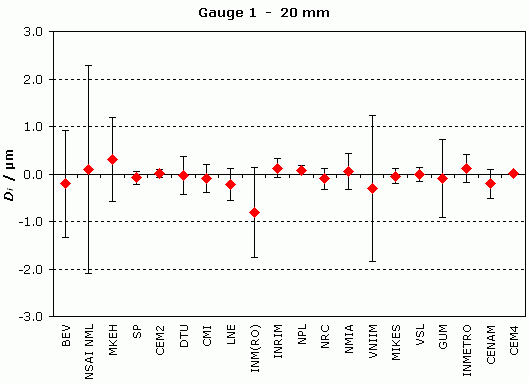
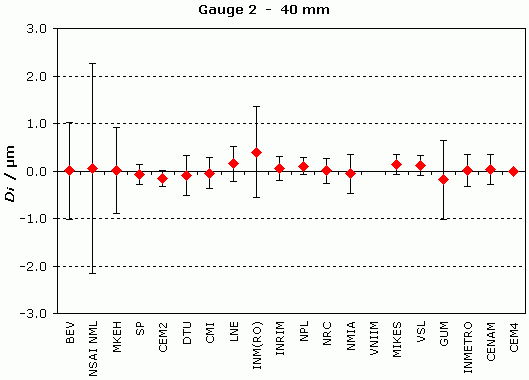
DVNIIM = -12.48 µm and UVNIIM = 1.55 µm
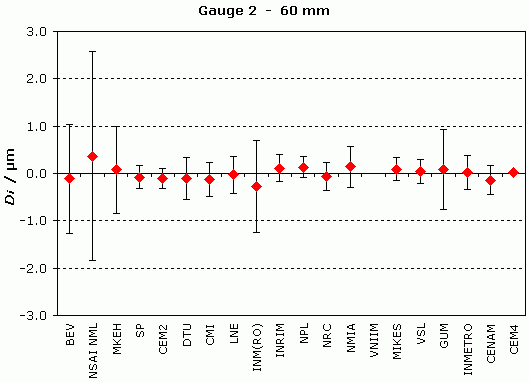
DVNIIM = -10.71 µm and UVNIIM = 1.56 µm
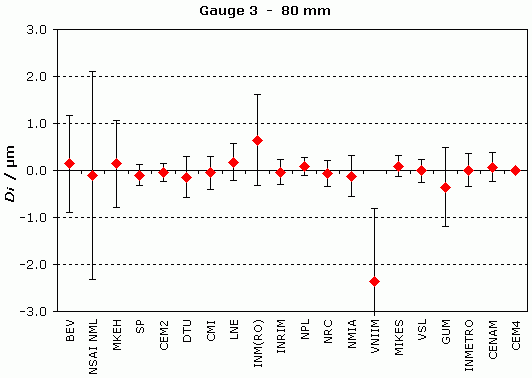
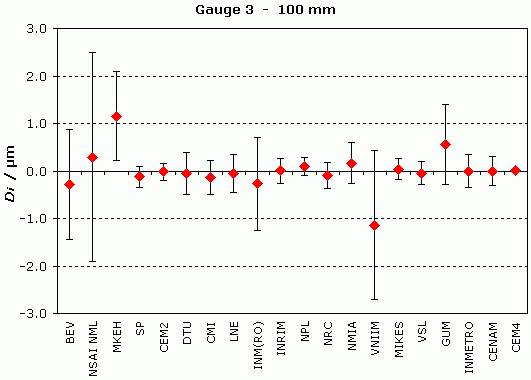
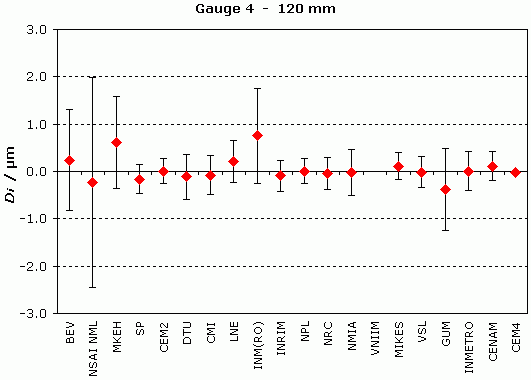
DVNIIM = 12.31 µm and UVNIIM = 1.58 µm
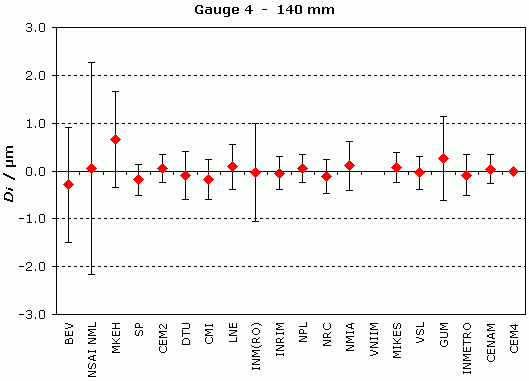
DVNIIM = 13.15 µm and UVNIIM = 1.60 µm
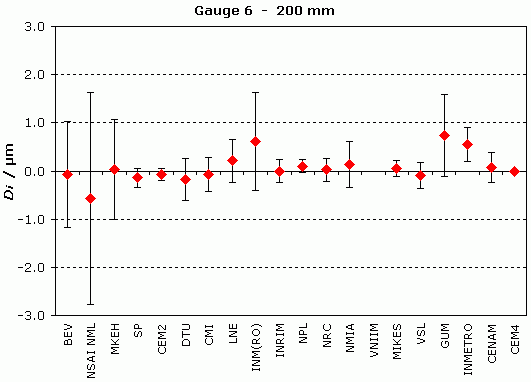
DVNIIM = 7.22 µm and UVNIIM = 1.61 µm
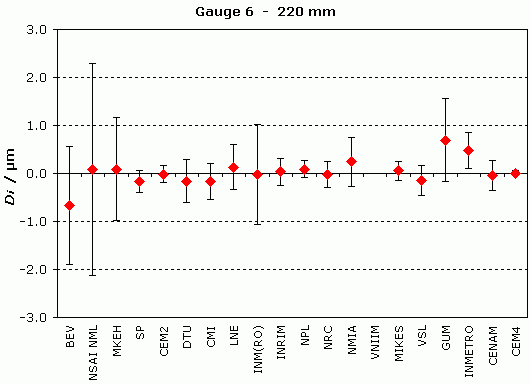
DVNIIM = 7.48 µm and UVNIIM = 1.63 µm
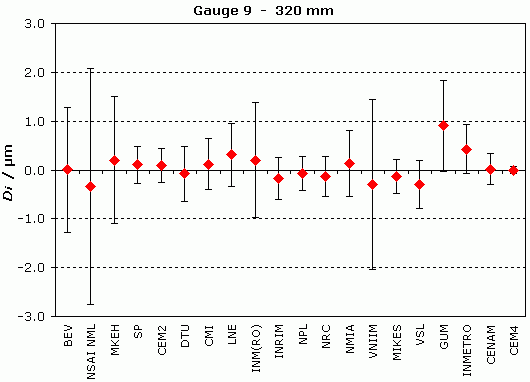
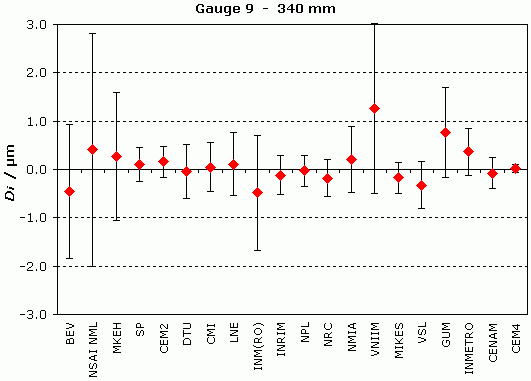
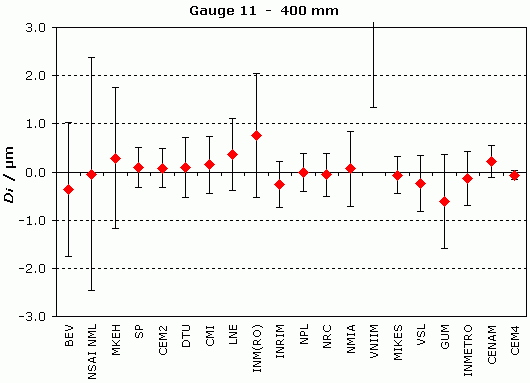
DVNIIM = 3.18 µm and UVNIIM = 1.83 µm
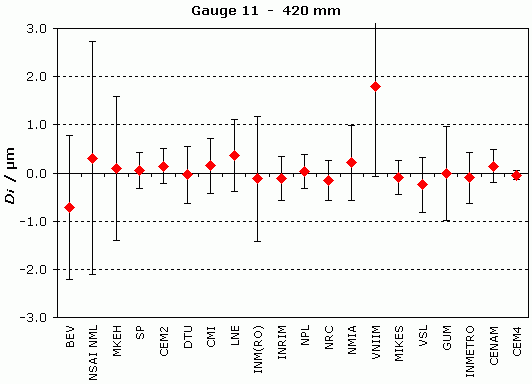
MEASURANDS : Distances of the centres of the front and back faces of the individual gauges of the step-gauge with respect of the centre of the front face of the first gauge
TRAVELLING STANDARD : A 420 mm long step-gauge with 11 gauges, designated as Gauge 1 to Gauge 11
Degrees of equivalence relative to the key comparison reference values are computed for Gauges 1, 2, 3, 4, 6, 9 and 11 only.
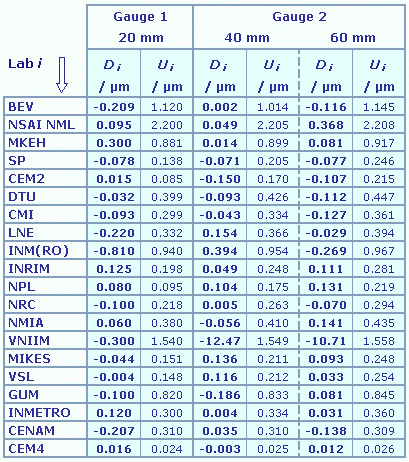
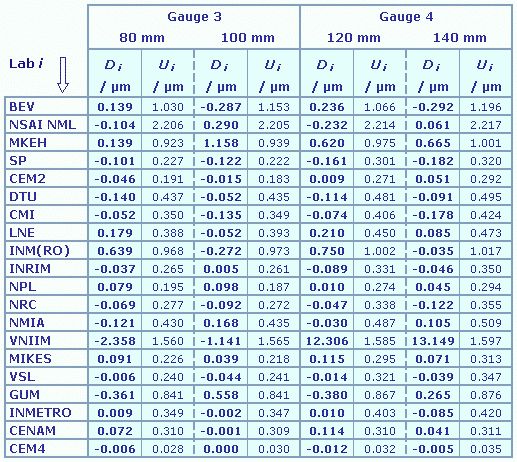
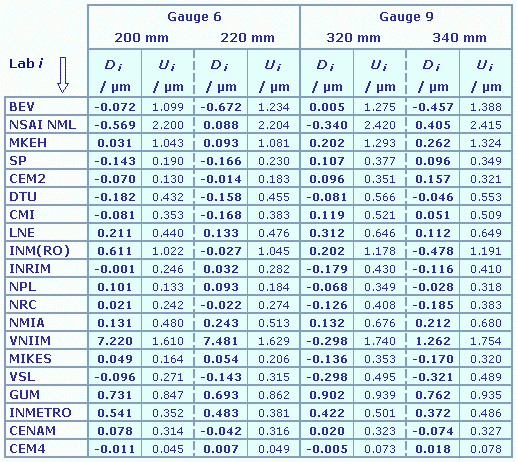
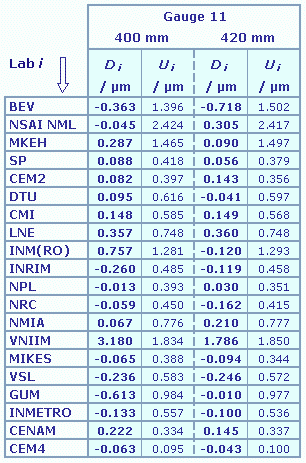
Unless otherwise stated, in the final numbers presented here, rounding has been applied according to ISO-31-0 Annex B Rule B.
Results are presented under A4 printable format in Summary Results (PDF file).
| Metrology area, Sub-field | Length, Dimensional Metrology |
| Description | Step gauge |
| Time of measurements | 2004 - 2007 |
| Status | Approved for equivalence |
| Final Reports of the comparisons | |
| References | |
| Measurand | Length: 420 mm |
| Transfer device | Step gauge |
| Comparison type | Key Comparison |
| Consultative Committee | CCL (Consultative Committee for Length ) |
| Conducted by | EURAMET (European Association of National Metrology Institutes) |
| RMO Internal Identifier | EUROMET Project No 777 |
| Comments |
Results published on 27 March 2012 Step gauge
|
| Pilot institute |
CEM
Centro Español de Metrologia Spain |
| Contact person | Emilio PRIETO +34 91 807 4716 |
| Pilot laboratory | |
|---|---|
| CEM |
Centro Español de Metrologia, Spain, EURAMET |
| BEV |
Bundesamt für Eich- und Vermessungswesen, Austria, EURAMET |
| CENAM |
Centro Nacional de Metrologia, Mexico, SIM |
| CMI |
Czech Metrology Institute, Czechia, EURAMET |
| DTU |
Technical University of Denmark, Denmark, EURAMET |
| GUM |
Glowny Urzad Miar, Central Office of Measures, Poland, EURAMET |
| INM |
National Institute of Metrology, Romania, EURAMET |
| INMETRO |
Instituto Nacional de Metrologia, Qualidade e Tecnologia, Brazil, SIM |
| INRIM |
Istituto Nazionale di Ricerca Metrologica, Italy, EURAMET |
| LNE |
Laboratoire national de métrologie et d'essais, France, EURAMET |
| MIKES |
VTT Technical Research Centre of Finland Ltd, Centre for Metrology/Mittatekniikan keskus, Finland, EURAMET |
| MKEH |
Hungarian Trade Licensing Office; now BFKH, Hungary, EURAMET |
| NMIA |
National Measurement Institute, Australia, Australia, APMP |
| NPL |
National Physical Laboratory, United Kingdom, EURAMET |
| NRC |
National Research Council, Canada, SIM |
| NSAI NML |
NSAI National Metrology Laboratory, Ireland, EURAMET |
| SP |
Technical Research Institute of Sweden from 2017 Research Institutes of Sweden AB, Sweden, EURAMET |
| VNIIM |
D.I. Mendeleyev Institute for Metrology, Rosstandart, Russian Federation, COOMET |
| VSL |
VSL, Netherlands, EURAMET |
This page proposes print-out on A4 paper (portrait) of the comparison details (best printed out using a black and white printer).
Please, select items to be printed out, then click on "OK" :
MEASURANDS : Distances of the centres of the front and back faces of the individual gauges of the step-gauge with respect of the centre of the front face of the first gauge
TRAVELLING STANDARD : A 420 mm long step-gauge with 11 gauges, designated as Gauge 1 to Gauge 11
|
For Gauges 1, 2, 3, 4, 6, 9 and 11, the key comparison reference value, xR, is obtained as the weighted average of the participant results, with exclusion of outliers (see Section 9 of the Final Report for the equations and the list of excluded values).
The linkage of the results of CENAM and CEM4 to those of the main group is explained in Section 10 of the Final Report. |
| In each case, the degree of equivalence of laboratory i relative to the key comparison reference value is given by a pair of terms: the deviation Di of the laboratory measurement to the reference value and the expanded uncertainty (k = 2) Ui of this deviation. |
| In each case, the degree of equivalence between laboratories i and j is given by a pair of terms: Dij = Di - Dj and associated expanded uncertainty (k = 2) Uij, computed as twice the root mean square of the individual standard uncertainties of the two laboratories. The pair-wise degrees of equivalence are not reported here, but can be found on pages 71 to 83 of the Final Report. |
MEASURANDS : Distances of the centres of the front and back faces of the individual gauges of the step-gauge with respect of the centre of the front face of the first gauge
TRAVELLING STANDARD : A 420 mm long step-gauge with 11 gauges, designated as Gauge 1 to Gauge 11
Measurement results, as reported by participants, and corresponding measurement uncertainties are given in Sections 6 and 7 on pages 19, 20 and 21 of the Final Report, and also summarized in Section 9.5 on page 43 of the same Report.
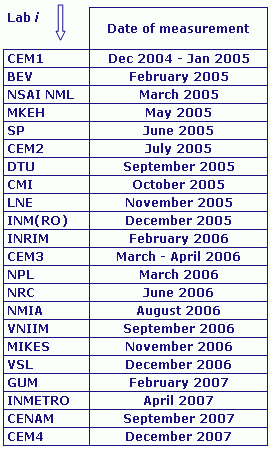
IPQ and NMISA resigned to measure for technical reasons.
CEM carried out four measurements designated as CEM1, CEM2, CEM3 and CEM4.
Only CEM2 and CEM4 are retained in the following, CEM1 and CEM3 having been used to assess the stability of the travelling standard, and for other purposes.
Looking at the evolution of the measured values along the time, the following actions were taken:
1. To exclude Gauges 5, 7, 8 and 10 from calculation, based on the large variations and anomalous behaviour observed on them by the Pilot Laboratory and the participants.
2. Assume that only Gauges 1, 2, 3, 4, 6, 9 and 11 are reasonably stable along the comparison and use them for the analysis. Although there is a reduction in the number of the gauges, the number of remaining ones is still valid for checking the capability of participants to calibrate step gauges according to their CMCs.
3. To leave out the results of CENAM and CEM4 and analyze them separately, as a secong group, linking later their results to the main group.